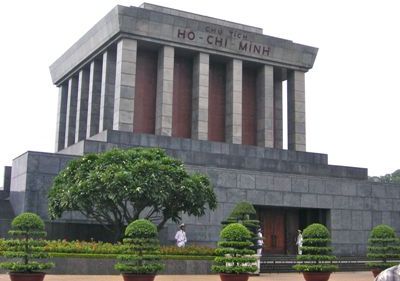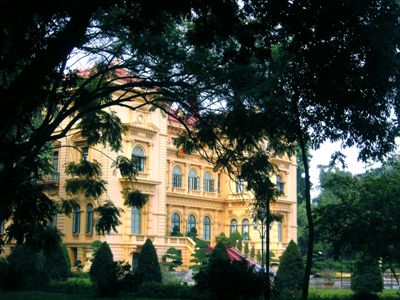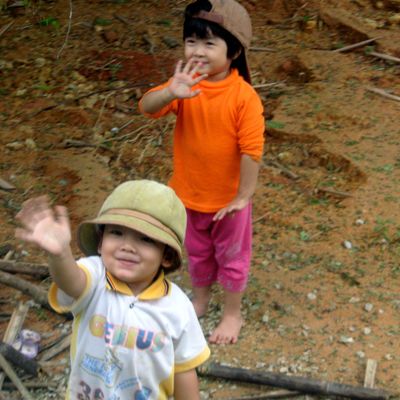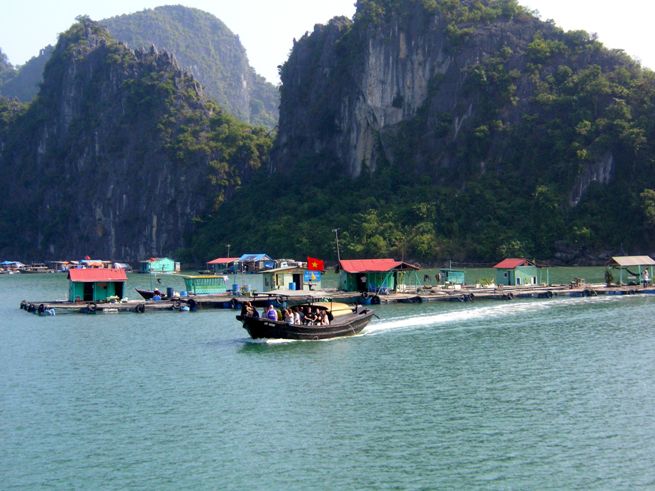































VIETNAM, AN EMOTIONAL JOURNEY
|
If you lived through the tumultuous times of the Vietnam War and experienced the bitter divisions in our country with student riots and demonstrations against the war, young men fleeing the country to escape the draft, and many college students sent to fight and die as soon as they graduated, you might have mixed emotions about visiting Vietnam. This would be especially true for those who fought there and will never forget the many horrors they saw.
Although it is a country with bitter memories for many people and might make them reluctant to want to visit, they would probably be very surprised by what it looks like today.
Hanoi is controlled by unsmiling, military men who demand obedience from their non-military countrymen. In spite of the military’s generally unwelcoming attitude, the general population is not unfriendly to foreigners.
| Ho Chi Minh’s giant granite mausoleum dominates Ba Dinh Square in an historic part of Hanoi, where it is guarded by armed honor guards. The mausoleum may be visited on certain days, although the embalmed body is taken to Russia for two months every year to be refreshed. |  |
| Nearby is the Presidential Palace surrounded by beautiful gardens, and the house on stilts where Ho Chi Minh chose to live as president instead of in the Palace. It was his wish to be cremated following his death, but his followers chose to disregard this desire and built the massive mausoleum instead. There are still some beautiful French colonial buildings that survived bombing from both the French and the U.S. |  |
| South Vietnam has a more relaxed, pragmatic atmosphere. Since a large part of the country’s population is under 30 years old, there is no apparent animosity towards Americans. In fact, our guide credits the resumption of trade with the U.S in the 1990s with reviving their economy.
Prior to that, he described Saigon’s/Ho Chi Minh City’s main square as a dirty, dangerous place full of drug dealers and prostitutes, and the country was steeped in poverty and starvation. With the resumption of international trade, these very industrious people were able to rebuild their cities with foreign investment. Tourism is now a very big part of their livelihood, and Saigon has luxury hotels and shopping to rival other Asian destinations. |
 |
 About an hour outside of Saigon, you can visit an area where the Viet Cong had an underground city with small armaments factories and other extensive underground facilities. The entrances to these areas were so well camouflaged that even the Viet Cong could not find them without maps. They could travel for miles underground sometimes almost crawling in low, narrow passageways.
About an hour outside of Saigon, you can visit an area where the Viet Cong had an underground city with small armaments factories and other extensive underground facilities. The entrances to these areas were so well camouflaged that even the Viet Cong could not find them without maps. They could travel for miles underground sometimes almost crawling in low, narrow passageways.
To prevent cooking smoke from giving away their location, it was carefully filtered through several different rooms away from the source, so it would not be visible when released above ground. The ingenuity can be appreciated, although it was a life and death struggle for both sides. Also present were many hidden traps above ground that could injure or kill anyone unfortunate enough to step on one.
Some members of our group were too young to have seen Vietnam in the 1960s and 1970s, but others seemed to have warily returned to see the changes. After years of remembering Vietnam from violent headlines and TV stories, it was satisfying to see a country that once again can be appreciated for its natural beauty and people who are living in peace and decent economic conditions.

Is a trip to Vietnam on your bucket list?

 "Flying high over the peaks of Alaska in our 6 passenger plane to Punchbowl Glacier was thrilling. Once on the ground, we boarded our dog sled for an exciting race across the glacier pulled by our team of eager, trained dogs – thinking the Iditarod! And who didn’t love playing with the 3 little future Iditarod puppies afterwards?! It was a wonderful way to enjoy Alaska on our cruise, and we all loved it. Thanks again for a wonderful vacation that was perfect for all ages in our family group." Ann & Steve
"Flying high over the peaks of Alaska in our 6 passenger plane to Punchbowl Glacier was thrilling. Once on the ground, we boarded our dog sled for an exciting race across the glacier pulled by our team of eager, trained dogs – thinking the Iditarod! And who didn’t love playing with the 3 little future Iditarod puppies afterwards?! It was a wonderful way to enjoy Alaska on our cruise, and we all loved it. Thanks again for a wonderful vacation that was perfect for all ages in our family group." Ann & Steve